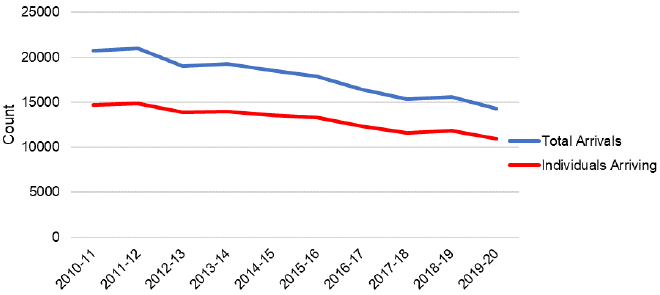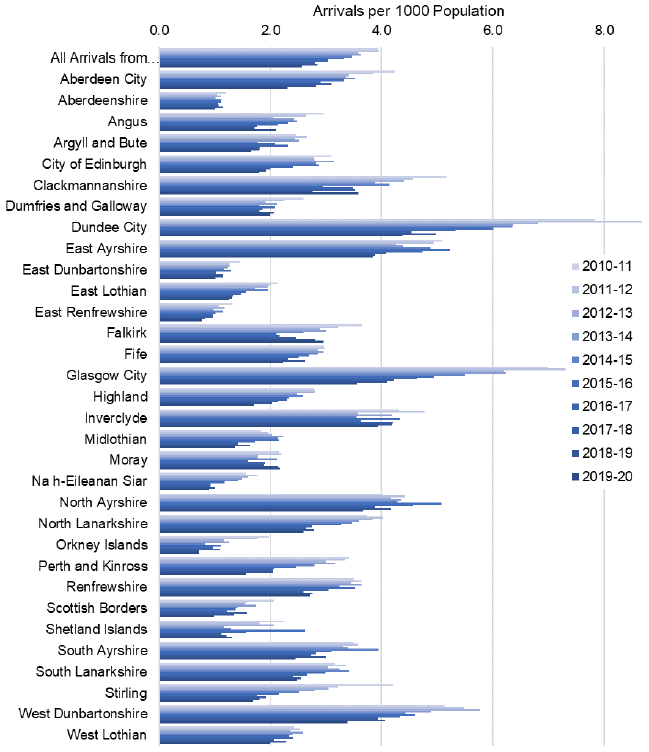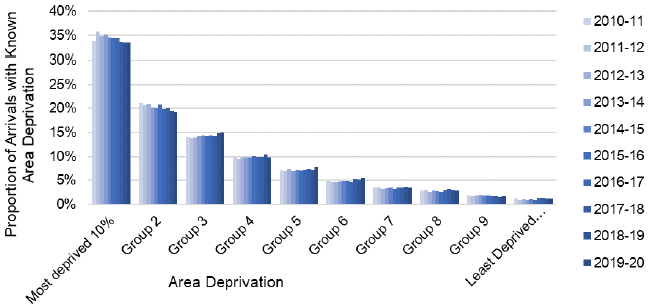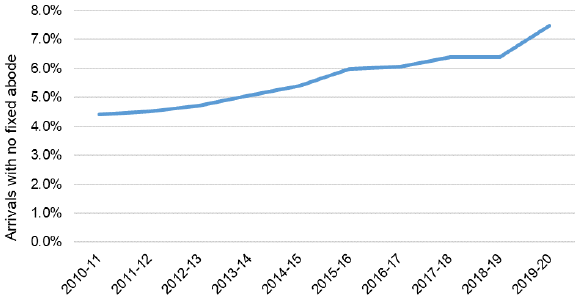Scottish prison population: statistics 2019 to 2020
This publication explores the characteristics of imprisoned people in Scotland. Following several years of sustained decrease, the prison population has risen sharply since 2017-2018 to an annual average of around 8,200 in 2019-2020.
This document is part of a collection
3 Arrivals
The current dataset allows identification of arrivals and departures (i.e. prisoners who enter or leave the care of the Scottish Prison Service) during an analytical period. An arrival is where a period of imprisonment begins for an individual, and is only counted as such if the arrival occured on a separate day from any previous departure for that individual.[10]
The information collected when an individual arrives into prison allows exploration of where individuals are drawn from. Addresses are collected on entry, allowing insight to geographical spread and extent of area deprivation, as well as living conditions (in terms of having fixed accomodation or no fixed abode). It is important to note that the status and location of a prisoner's address may change during the time served in custody.
3.1 Total Arrivals & Individuals Arriving
(Data tables C1, E1)
The number of individuals who arrive in prison one or more times in a year fell 26% over the past decade, from 14,709 in 2010-11 to 10,937 in 2019-20 (Figure 7).

A single individual can arrive at prison multiple times within a year. However the proportion of individuals doing so has fallen over the past decade. In 2010-11, 28% had two or more arrivals, while by 2019-20 this had fallen to 23%. This is likely due to a reduction in short custodial sentences.[11]
As a result, the total number of arrivals has fallen faster than the number of individuals arriving. Arrivals fell by 31% over the past decade, from 20,721 in 2010-11 to 14,324 in 2019-20.
Because a prisoner's address - and therefore local authority and deprivation status - may change between stints in prison, in this section we count all arrivals permitting the double-counting were people arrive more than once in a year.
3.2 Local Authority
(Data table C2)
Looking at geographical spread of arrivals in terms of local authority, the proportion of arrivals per local authority is broadly in line with the overall population level of each. Looking at rate of imprisonment per head of population though, Dundee City consistently provides the highest number of people arriving in prison per head over the past ten years (Figure 8).

3.3 Deprivation
(Data table C3)
Identifiying the Scottish Index of Multiple Deprivation (SIMD)[12] rank of available prisoner addresses highlights the clear links between experience of area level deprivation and likelihood of arriving in prison.
The 10% most deprived areas are over-represented in prison arrivals by a factor of three (Figure 9). The top 60% of areas (group 5 and above) are under represented by increasing degrees as their area deprivation decreases. This relationship has been more or less static over the past decade.

Looking at Figure 9 above, there are some indications that the over-representation from the most deprived areas has reduced by a small degree in the past ten years, and that representation in groups 3 through to 6 has increased marginally.
Prisoners with no fixed abode, addresses outwith Scotland, or those where address information is missing altogether, are omitted from this analysis. This removes around 10% of arrivals in each year of analysis.
3.4 No Fixed Abode
(Data table C4)
Individuals arriving in prison are asked to provide an address; where they do not, they are registered as no fixed abode. People may respond in this way because they do not wish to give their home address, e.g. if they do not wish to associate their stay in prison with a family home.
Nevertheless, keeping these caveats in mind, the proportion of individuals arriving in prison who report having no fixed abode has increased over the past decade, from 4.4% to 7.5% (Figure 10).

Contact
Email: justice_analysts@gov.scot
There is a problem
Thanks for your feedback